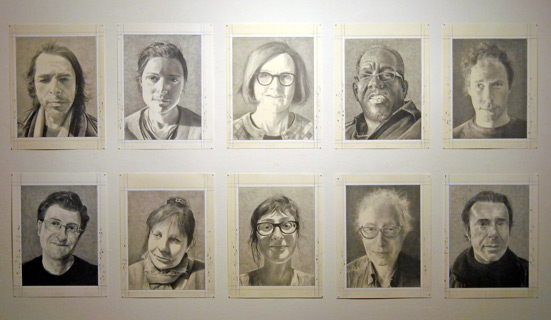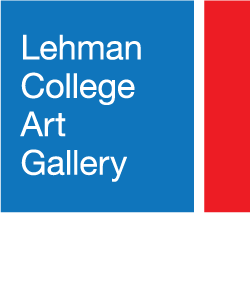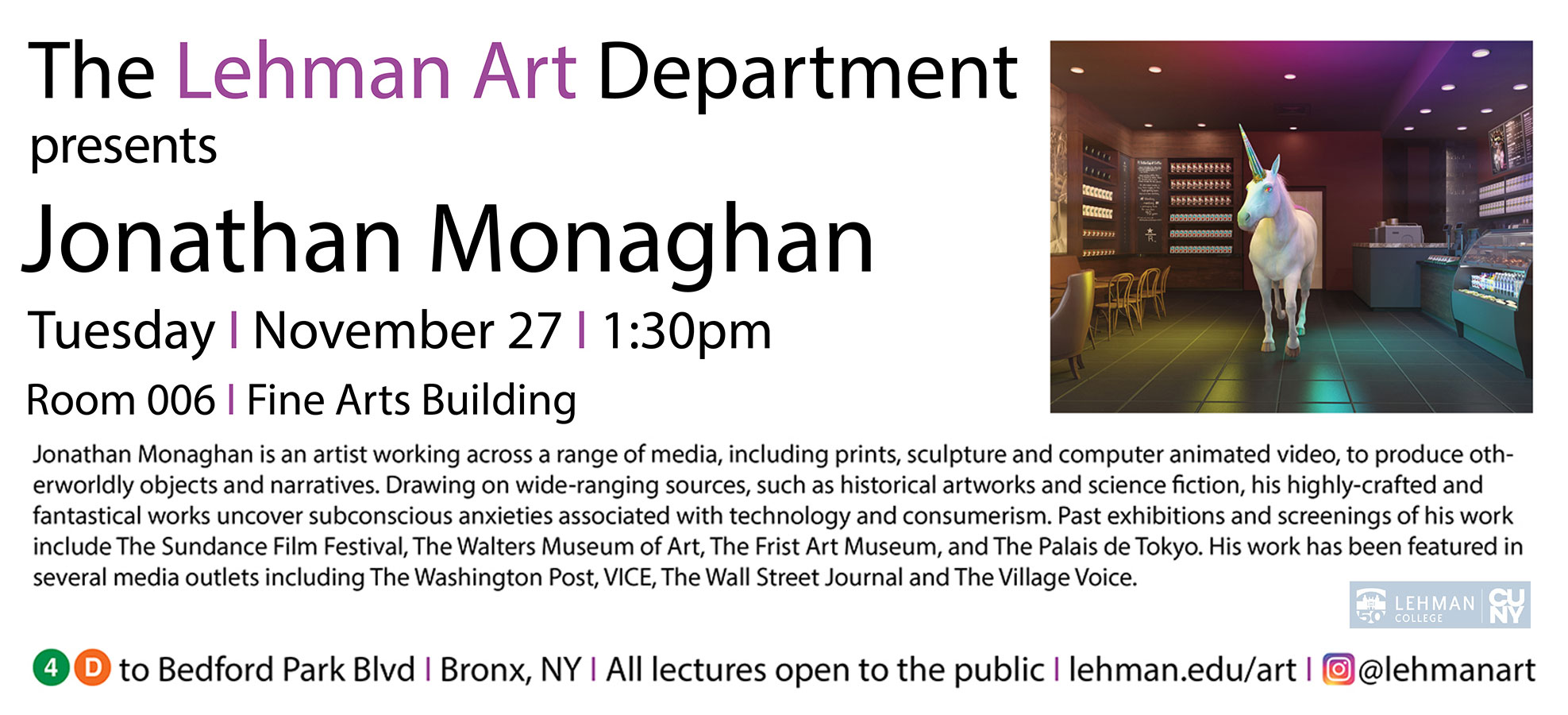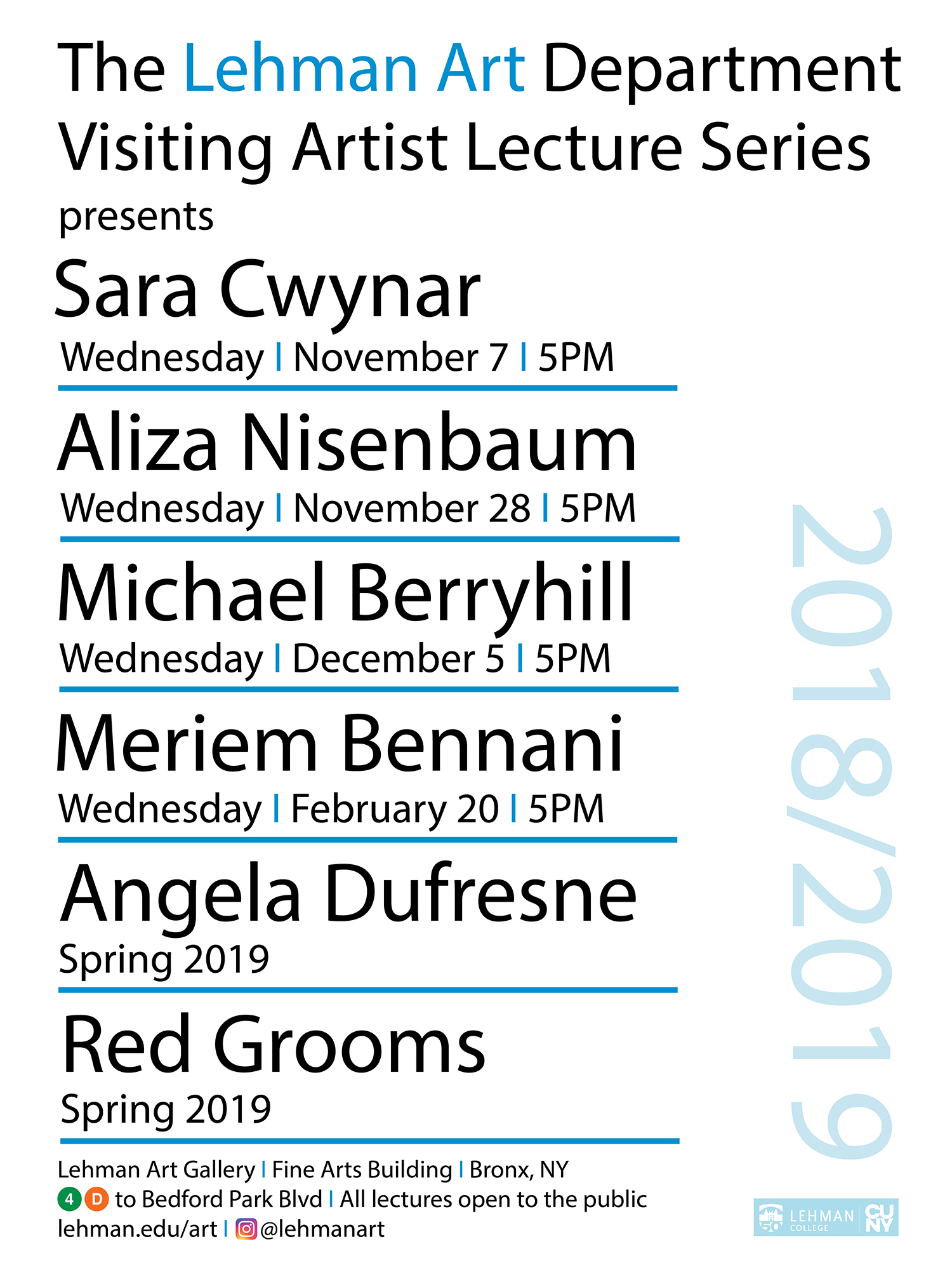Beyond Appearances
The Individual Beyond the Exterior Visage
John Ahearn, Eleanor Antin, Dotty Attie, Dawn Black, Eugene Brodsky, Phong Bui, Nick Cave, Ain Cocke, Andrea Dezsö, Chitra Ganesh, Julie Heffernan, Teun Hocks, Nina Levy, Whitfield Lovell, Kerry James Marshall, Bradley McCallum & Jacqueline Tarry, Charles McGill, Yasumasa Morimura, Orlan, Tony Oursler, Robert and Shana ParkeHarrison, Dulce Pinzón, Lucia Pizzani, Wanda Raimundi-Ortiz, Daniel Rozin, Karin Sander, Andres Serrano, Devorah Sperber, Hank Willis Thomas, Rigoberto Torres, Alejandra Villasmil, Kara Walker, and Deborah Willis
Beyond Appearances offers a sampling of contemporary portraiture, bringing together a group of artists whose works explore the individual beyond the exterior visage. Historically portraiture has always conveyed far more than physical features and these portraits touch on many issues – social, historical, political, ontological – with insight and sometimes humor. The exhibition includes a number of works in which the artist is present as a subject, incidentally in some instances, creating self-portraits. These include the work of Charles McGill, Julie Heffernan, Yasamasa Morimura, Chitra Ganesh, Teun Hocks, Tony Oursler, Orlan, Lucia Pizzani, Robert and Shana ParkeHarrison, and Andrea Dezsö. There is also a van Gogh self-portrait by Devorah Sperber. There are several collaborative works, some by artists who primarily work individually and others known for their work together. This group includes: husbands and wives Bradley McCallum and Jacqueline Tarry and Robert and Shana ParkeHarrison; mother and son Deborah Willis and Hank Willis Thomas; and collaborators Rigoberto Torres and John Ahearn. The exhibition offers a broad range of media – painting, drawing, sculpture, photography, video, and multimedia installation – and explores portraiture through the work of artists with diverse approaches.
John Ahearn and Rigoberto Torres work together as well as individually. Their collaboration began in the Bronx in 1979 while Ahearn was making direct, life-castings from people in the neighborhood at Fashion Moda, a newly founded alternative space in the South Bronx. Torres became a subject, then an assistant and later a collaborator and artist. Often their castings are made in public places lending an element of performance to their process and further connecting their work to the community. In Beyond Appearances, Romulus and Laica, 2006-07, and Edimar, 2008, are figures from a large public art project created for the Inhotim Centro de Arte Contemporânea, a major art collection with a focus on site-specific work located in the state of Minais Gerais in Brazil. There too the artists worked with the local community, capturing scenes from daily life and the celebratory Afro-Catholic religious practices of Moçambique Congada. Edimar, with festive ribbons in his hat, leads a procession of drummers. The figures are part of a gathering at the Brumadinho bus stop. The guard and dog were cast using a member of the center’s security team as a model. (The dog was tranquilized for the casting.)
Performance artist and filmmaker Eleanor Antin probes history, drawing parallels to contemporary life. The Golden Death from The Last Days of Pompeii, 2001 is part of a photographic sequence. Created in the style of 19th century salon painting, they recall artists like Lawrence Alma-Tadema and his depictions of the ancient Rome. Antin’s photographs were staged in a villa in the affluent town of Rancho Santa Fe, California, in the hills north of La Jolla. The actors are shown as sybarites devoted to luxury and pleasure. Their languorous figures are literally blanketed in coins. They enjoy the good life while on the brink of destruction, oblivious to the rumblings of Vesuvius – perhaps, like Californians living on geologic faults or more broadly, contemporary society at the edge of disaster distracted by unbridled consumption. The work was completed shortly before September 11, 2001.
Notions of beauty and the pressure brought to bear on women is a theme in the work of several artists, all women – Orlan, Dotty Attie, and Alejandra Villasmil. Dotty Attie appropriates imagery from art history and from popular culture. She has often focused on gender politics and the dominance of male representation, reinterpreting and re-contextualizing the works of the masters. In Attie’s multi-paneled work Skin Deep, 2007, she deals with the torturous quest for beauty as a woman submits to a vast array of procedures – facials, girdles, exercise machines, hair curling, high heels – in order to be attractive. Attie paints the small canvases using found images from vintage magazine illustrations and photographs and intersperses them with text panels. In the final panel of the work, the woman is dressed and ready for her man who waits in the background. The text, intended to examine and critique the relative nature of social behaviors, reads: “Sometimes a traveler in foreign lands / Where customs and mores are unfamiliar / Will find / Persistence / and perusal / Mean consent.
Conceptual/performance artist Orlan, known for radical physical transformations to her face and body through plastic surgery, thinks of her body as a Duchampian readymade. She has explored the notion of “ideal” beauty by examining the standards of various art historical periods from Leonardo to Boucher and transforming her. Orlan’s operations became orchestrated performances with music, poetry and dance that she choreographed. Her surgeries have been exhibited as installations, photographs, and video. The connections between the pain and beauty have also been present as a subtext in her work. Again drawing on the history of art, Refiguration / Self-Hybridization, Pre-Columbian Nº8, 1998, is from a series of digital alterations that merge stone Olmec and Mayan heads with Orlan’s own — without surgery. Here her head, presented against an aqua background, is given pink flesh tones and vivid red lipstick.
Notions of ideal beauty and social expectations also play out in Alejandra Villasmil’s series entitled Extreme Makeover. Adding drawing and collage, she intervenes and alters “found images” of women from vintage fashion magazines. Villasmil uses pictures from the 40s and 50s, a time when women’s roles were well defined and were restricted by mores. She subverts these portraits with political, social and sexual commentary, using strategies connected with Dada and Surrealism– appropriation, “free association” of images, and collage – to explore dialectical tensions: Censorship / Free Speech; Concealment / Disclosure; Fragmentation / Reconstruction; Glamorization / Degradation.
Yasumasa Morimura appropriates well-known images from art history and pop culture. Using his own face and body – along with make-up, costumes, prosthesises, and sometimes, digital manipulation – he restages iconic images – from the Mona Lisa to Frieda Kahlo and Audrey Hepburn to Che. In Ambiguous Beauty/Aimai-no-bi Morimura recreates the familiar Marilyn Monroe pinup (taken by Tom Kelly in 1949) as part of a multiple edition of 5000, created for the Norton Christmas Project in 1995. (Since 1988 computer software entrepreneur and art collector Peter Norton and his family have commissioned artists to create a multiple edition of their work as a holiday greeting to send to friends and colleagues.)
In 1997 Walker created a pop-up book, Freedom: A Fable by Kara Elizabeth Walker, also for the Norton Family Christmas Project, in which an ex-slave dreams of going to Liberia. Kara Walker is known for her cut-paper silhouettes that explore race, power, sexuality, and the violence of the antebellum South. Often life-size, her figures are drawn from American history and the imagination and they are far more animated than the staid 18th century black paper cutouts. No stranger to controversy, Walker’s images often include exaggerated features and negative stereotypes that make everyone uncomfortable. Layered cutouts bring to life the two-dimensional silhouettes.
Ain Cocke explores the shifting nature of societal norms, representation, and meaning. He collects photographs and works with them as a stimulus for the images he paints. In a recent series Cocke explores male identity and relationships in the World War I and World War II era and the period’s accepted intimacy among men. In Down in the Valley, 2009, two men pose together with their arms entwined signified camaraderie rather than homosexuality. They are set in a lush mountain landscape with pink highlights and purple shadows. Cocke’s style has been compared to that of Rococco artists such as Boucher and Fragonard but it also recalls American painters – the sailors Paul Cadmus and the rosy tones of Maxfield Parrish.
Nina Levy’s figurative sculptures probe the psychological as well as the physical appearance. Most recently they explore family dynamics. Levy’s son Archer, who was almost two years old, served as the model for Large Head, 2005. It was created from the mold originally conceived for Toss, 2005, an installation in which two life-sized, headless parents on trapezes toss the colossal child’s head between them. Levy models her sculpture from observation – they do not involve life casting. Large Head was modeled in Styrofoam and plaster rather than clay, and then cast in polyester resin. Disembodied, the child’s head demands attention and turns the tables on viewers in the gallery who become the tiny ones.
Bronx-born Whitfield Lovell creates tableaux that depict the domestic lives of African Americans, illuminating a world rarely seen in the history of art. Skillfully drawn, life-sized portraits on old, salvaged wooden planks are combined with found objects. Lovell collects old photographs and thrift shop items – anonymous objects that come with the patina of use and a history of their own. His interest is the life of regular people and focuses on the period of American history from Emancipation Proclamation through the Civil Rights era. Surrounded by a silver tea service and a table with a lace cloth, the couple in Duece seems informally posed, giving an intimate glimpse of a home and a life. A sugar bowl is attached mid-air between the couple. Perhaps they are “sweethearts.”
Chitra Ganesh explores a moment in Indian history in The Awakening, 2004. She poses as the legendary warrior queen Lakshmibai, The Rani of Jhansi, a symbol of resistance to British rule, also known as the “Joan of Arc” of India. The rani died in battle at the age of 21 in the Indian Rebellion of 1857. Ganesh dramatically enacts the moment of the rani’s death in this staged photograph. Her clothing is modeled after 19th century Indo-Persian armor.
Wepa Woman is a Puerto Rican superhero created by Bronx video and performance artist Wanda Ortiz. (Wepa is a Puerto Rican term of affirmation.) The character was developed when Ortiz was 19 and working with an informal, comic artists collective. She realized the Latina voice was missing and . . . Wepa Woman was born along with Chuleta, her nemesis. The latter, whose name means “pork chop” in Spanish, is a character in Ortiz’s performances and a source of humor. In our drawing Untitled, Wepa Woman Strikes Backboard series, 2006, Wepa Woman uses her “Key Chain of Justice,” a nod to Wonder Woman’s Lasso of Truth, as a grappling hook to scale a building. Full of chochkas — teddy bears, hearts, Narcotics Anonymous medallions — the keychain becomes a mighty tool in the hands of Wepa Woman.
Dulce Pinzon’s “The Real Stories of Superheroes,” a series of 20 color photographs, features Latino immigrant workers performing the menial and often dangerous tasks that often are invisible to most of us. Dressed in the costumes of popular American and Mexican superheroes, these ordinary men and women are shown in their workplace. A short text provides the worker’s name, hometown, and amount of money they send to their families each month, providing a sense of who they are and why they work so hard. In Spiderman is Bernabe Mendez, 2007, the superhero, Mendez, is from the state of Guerrero, Mexico, and works as a professional window cleaner. He sends $500 a month home.
Kerry James Marshall grew up in Birmingham, Alabama, during the turbulent years of the civil rights era, then moved to South Central Los Angeles and was there during the Watts riots and the shootout between the Black Panthers and the police. His work focuses on the African American experience and brings a social and political perspective to his depiction of regular people and their communities. Den Mother, 1996, offers a beatific portrait of an important community leader. Her skin is an exaggerated black like the figures in many of Marshall’s paintings. Her hair is closely cropped and a small nose stud catches the light. Surrounded by the jagged rays of a comic book halo, this leader from Troop 47 is presented as a beatific figure and another everyday superhero.
Robert and Shana ParkeHarrison are known for their staged photographs that probe the relationship of humans and nature. Their poetic and sometimes surreal images depict a landscape savaged by technology and nature badly out of balance. In Ashen Head, 2008, like the photographs, Robert is present as an “everyman” with the bronze castings made from his head and hands. His white starched shirt seen in the photographs, is now dirtied and without the jacket. With long arms extended, the hands gently hold the head. The bronze is rubbed with ash, a reference to death, decay, and renewal — “earth to earth, ashes to ashes, dust to dust.” The ash is a recycled material the artists collect from fueling their home and studio over the long New England winters.
Dutch painter Tuen Hocks creates large-scale allegorical portraits that explore life’s existential dilemmas. He is also present in the work as the protagonist, an “everyman,” who bumps up against situations that are both absurd and familiar. Hock constructs large stage-like sets in his studio then photographs the work in black and white. He then paints directly on the print. In Untitled (road that stops), 2004, a lone figure has reached the “end of the road” – a path in the shape of a large question mark. He contemplates a pile of smoldering debris that includes an artist’s pallet among other things.
Phong Bui, artist, writer, and curator, is also the editor and publisher of the monthly journal The Brooklyn Rail, which offers critical perspectives on arts, politics, and culture in New York City. His drawings accompany interviews of artists and critics. In this exhibition we have a selection of drawings that have been translated into photoetchings. The subjects, developed from photographs made for interviews, are warm and expressive. The portraits include Matvey Levenstein, Nathalie Provosty, Roberta Smith, Stanley Whitney, Cordy Ryman, Alfredo Jaar, Lisa Yuskavage, Pipilotti Rist, Terry Winters, and Robert Lawlor.
Known for his disembodied video heads that are projected onto three-dimensional objects like pillows and dolls, Tony Oursler’s work has always explored the human psyche in ways that are at once very familiar, yet surreal and a little bit creepy. In this exhibition a large aluminum work shaped like an amorphous splat, combines sculpture, painting, video, and performance. Developed as an extension of his drawings and collages, the face is fragmented and painted green to match the aluminum surface. The red-rimmed eyes and mouth move in vivid contrast to the green skin tones. A mouth whispers softly and draws the viewer in closer.
With a background in fiber arts, dance, and haute couture, Nick Cave is probably best known for his Soundsuits, sculptural wearables created from found materials such as fabrics, beads, old bottle caps, sticks, and twigs, that makes sounds when worn. The images visually connect to a number of sources – African ceremonial costumes, Mardi Gras costumes, folk art, and flea market finds. Untitled, 2009, is from a recent series of sculptures incorporating lawn jockeys, a bit of Americana intended to be somewhere between kitschy and offensive. The white-faced figure hoists above him a well-worn homemade rug with concentric bands of color, like a garage sale mandala.
Julie Heffernan’s sumptuous allegorical paintings, often set in grand ballrooms or extravagant courts, exist in a world of fantasy, somewhere between the Baroque and the Rococo. In Self Portrait as Wild Hair, 2007-08, the artist is spotlighted in the foreground before a seated monarch whose looming figure fades into the shadows. She is nude, clothed only in her extravagant hairdo. White mice nest in her tresses. The room is filled with birds – hawks, doves, and a vulture with a snake in its mouth.
Hank Willis Thomas skillfully manipulates the symbols and images of pop culture and advertising to explore race, power, and stereotypes. In It Didn’t Jest Grow by Itse’f, 1984/2008, two found photographs — one of a woman picking cotton and other, a woman harvesting tea leaves — he uses humor as a gentle reminder that there is often unacknowledged labor involved with the things we use everyday. Smiling as they work, the two women are also reminders of slavery and colonialism.
Charles McGill’s Arthur Negro is a fictitious character whose background includes a radical past and a present life golfing in suburban country clubs. McGill’s hyper-realistic sculpture Arthur Negro II, 2006-09, is created from a cast of the artist’s body. Stylishly dressed in golfing attire, the sculpture is filled with specific references to Arthur’s activist days. He is posed with golf bag and clubs, one of which is adorned with dreadlocks. The golf bag offers a collaged overview of social and political history, among them images of Rosa Parks, Redd Foxx, Snoop Dogg, Condi Rice, Frederick Douglass, the Black Panthers, and O. J. The pedestal is a city street with manhole cover (cast on the street in New Rochelle) and its border too is layered with historical references – from Malcolm X to the Funkadelics. McGill approaches the complexities of identity and the expectations of stereotypical consistency with humor. (Another work in this series was commissioned by the Bridge Country Club and can be seen in The Bridge Pro-Shop, Bridgehampton, NY.)
Photographer and photographic historian Deborah Willis uses the camera to explore narratives about family life, often adding text with the image to flesh out meaning. After Madonna, 2008, is part of a series created as a collaboration with Hank Willis Thomas (her son and also in this exhibition with another work). The image is of a friend and colleague, art historian Cheryl Finley who teaches at Cornell. Finley is shown with her four-month-old daughter Noura in a powerful image that resonates with centuries of Western art. The figure is at once traditional in its frontal pose yet contemporary in her direct gaze at the viewer.
The collaborative team of Bradley McCallum & Jacqueline Tarry uses a wide range of media to explore social justice, race, and communities. In this exhibition a grouping of mug shots from The Evidence of Things Not Seen Mug Shots, is based on the arrest photographs from the first wave of the 1955-56 Montgomery Bus boycotts. The individual mug shots are painted in oil on linen with an overlaid photographic image of toner on silk. The arrest number is only present on the silk layer. The double layers make a ghostly portrait that seems to shift as the viewer passes. The somber faces, framed like formal portraits, pay tribute to the individuals arrested in the early days of the civil rights movement.
The photographs of Andres Serrano have often been the center of controversy – from religious sculptures photographed in urine to cadavers in the morgue, and portraits of Klansmen. In the late 1980’s Serrano began to photograph the homeless. In 1987, he worked near by at the Sharing Community in downtown Yonkers where he photographed clients as well as staff. Untitled, 1987, is study from this series. With the figure isolated against a black background, the skin tones starkly contrast in this color-saturated Cibachrome. The pose and lighting suggest an Old Testament prophet. (Those photographed received a print as a thank you for posing.)
Devorah Sperber’s After van Gogh (Self Portrait), 2008, seems to be beautiful abstract patterns until viewed through the optical ball that accompanies the work. The ball renders an inverted pointillist-like image created from 408 spools of thread, into a tiny upright and coherent portrait of van Gogh. There is an “aha” moment when it all comes together. In this series Sperber revisits well-known portraits from the history of art and figures from popular culture. The work combines an unusual approach to materials with sophisticated optics.
Daniel Rosin captures the viewer’s portrait in his interactive Peg Mirror. It is a digital work designed with a camera, a computer, and 650 wooden pixel-like pegs, each with its own motor. The non-reflective pegs swivel and cast shadows capturing both still and moving images. Silhouette-like images result when standing at a distance from the work and an articulated pattern of darks and lights reveal a more detailed view of the face when the viewer is closer. Like Devorah Sperber’s pixilated image, Rozin’s depends on the human perception to make sense of the image. As the work responds to the movements of the viewer, there is a soft clatter, like a gentle rain.
Meticulously detailed from his inquisitive stance to his rumpled jeans, the small almost 8” figure of Gian by Karin Sander is created without the artist’s direct intervention. Her subjects choose their clothing and their pose, further removing the artist from the process. Gian 1:5, 2008, is a machine-produced replica of a boy captured in a particular moment in time. In this series, Sander uses three dimensional laser cameras to scan the entire surface of the subject’s body. The scans takes approximately 20 seconds and over the course of thirty to forty hours, the figure is built in thin layers by an extruder that digitally reads the scan.
Dawn Black, a New Orleans native, explores masks, costumes, and disguises in a series of small drawings from The Conceal Project. She finds most of her images on the Internet. They seem as familiar as a story on the evening news or a spread in a National Geographic. Black works on beige-toned paper that makes the white gouache pop out in contrast. Her delicate, detailed figures are an incongruous group of characters including a hooded Abu Ghraib captive, a plump ballerina, and a child in a Halloween skeleton costume.
With small mirrors and colored frames, Lucia Pizzani studies the body using photography — not in its entirety but as fragmented parts. Usually shown in groups of photographs, the individual works become part of a larger composition and probe the notion of a post-modern body: hidden, incomplete, and divided. In Untitled, 2007, the body becomes a formalist abstraction composed of bright colors and muted skin tones with its segmented forms defined by negative spaces.
Eugene Brodsky’s imagery has a simplicity that belies his process. The line drawings remind you of something you’ve seen before but can’t quite place – the graphic sense of a cartoon or a splash of graffiti or a weathered billboard with earlier posting showing through. Brodsky works with a transfer process; editing and altering; pushing the image into printmaking, video, digital manipulations, or painting; and back again. Each step of the transformation removes the image further from its source. In this exhibition a simple line drawing of a girl is collaged from torn pieces that have been reassembled with her features almost imperceptibly misaligned. She nonetheless seems balanced and composed.
Romanian-born New York-based artist Andrea Dezsö’s visual content is drawn from her life—childhood in Romania, family relationships, immigration to Hungary and then to America, life in New York—as well as a rich imagination populated with fantastic creatures and aliens. In this exhibition all three of her Kaleidoscopic Drawings, 2004, include self-portraits. A somewhat more conventional portrait is in the center and is flanked by “Taking a bath with my sister,” based on a childhood memory, and the humorous “Self portrait with favorite foods.”
Portraiture with is its expansive history is always evolving through the new work of artists who rethink and interpret what exists. In this exhibition – each approaches the subject with different presuppositions, exploring history, the media, or their own interior and allows the viewer insight into a time, a place and a persona.



